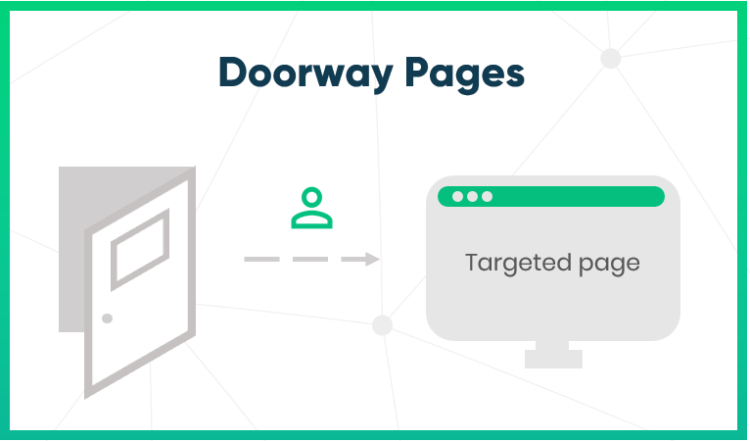Doorway pages are special web pages created solely to rank high in search engine results for specific keywords or phrases. These pages often lack substantial content or utility for visitors, serving primarily to manipulate search engine rankings. Upon accessing a doorway page, users are typically redirected to a different page.
A key aim of doorway pages in search engine optimization (SEO) is to boost traffic to a website by exploiting search engine algorithms. This practice is generally frowned upon in the SEO community. Search engines penalize websites using doorway pages, potentially leading to sanctions or bans.
For instance, if a website’s main page is titled “Best Men’s Jewelry,” the owner might generate numerous derivative pages, such as “Best Men’s Jewelry in California,” “Best Men’s Jewelry in Los Angeles,” and “Best Men’s Jewelry in San Diego.” However, these pages provide little relevant information and primarily funnel users back to the main site, acting as “doorways.” These pages do not offer meaningful value to their visitors.
The concept of doorway pages is distinct from landing pages, which are designed to convert visitors into customers or leads. Landing pages typically provide relevant information and a call-to-action, whereas doorway pages are more manipulative in nature.
Understanding how to create doorway pages involves recognizing the thin line between legitimate SEO practices and tactics that can harm a website’s reputation. Utilizing doorway pages checker tools can help identify such pages. However, it’s important to prioritize quality content over deceptive SEO strategies.
Types Of Doorway Pages
Doorway pages come in different styles, each with its own way of not really helping the user. Let’s look at the various types you might come across.
Spammy City/Region Pages
These pages target specific places like cities or regions. But here’s the catch: they don’t offer much useful information. Their main goal is to show up in local searches without actually providing anything valuable for people looking for local content.
Microsites
Then we have microsites. These are like mini websites focusing on a certain topic or keyword. The problem is they often don’t have enough good content. They’re mainly made to get traffic from searches, not to give users a full, informative experience.
Indexable Internal Search Results Pages
These pages are a bit tricky. They look like search results inside a website but just lead you around in circles. You think you’ll find what you’re looking for, but end up not getting the info you need.
Duplicate Content with Slight Keyword Changes
Finally, there are pages that use almost the same content but change a few keywords here and there. It makes it seem like each page is different, but really, they’re all pretty much the same. This doesn’t give users anything new or helpful.
Doorway Pages Vs Landing Pages
Let’s break down the differences between doorway pages and landing pages. People often get them mixed up, but they’re actually really different.
- Purpose: Doorway pages trick search engines to get better rankings. Landing pages, on the other hand, give users a specific and relevant spot to land on, especially when they come from an ad or a campaign.
- Content Quality: Doorway pages usually have low-quality content that doesn’t help users much. Landing pages focus on high-quality, relevant content that’s meant to engage and help visitors.
- User Experience: With doorway pages, users often end up frustrated because they’re misleading and don’t deliver what they promise. Landing pages aim to make users happy by matching what they expect to find with good content and design.
- SEO Compliance: Doorway pages go against what search engines say is okay and can get a website into trouble. Landing pages follow the rules and work to improve rankings in a fair way.
- Keyword Usage: Doorway pages might cram in a lot of irrelevant keywords just to manipulate search rankings. Landing pages use keywords that make sense and match what users are looking for.
- Internal Linking: In doorway pages, you often find weird linking setups that are there just to mess with rankings. Landing pages use links wisely to help users move around the website and find what they need.
- Value Proposition: Doorway pages just try to move users to other parts of the site or different sites without offering much. Landing pages clearly show the value of a product or service to get users interested or to buy something.
- Legitimacy: Doorway pages are seen as a big no-no in the web world and break search engine rules. Landing pages are totally fine and are a common, ethical way to market and engage with users.
- Conversion Goal: Doorway pages often don’t have a clear goal to get users to do something specific. Landing pages, however, are made with clear goals like getting leads or making sales.
- Tracking and Analytics: Doorway pages might not have tools to track how users behave on the page. Landing pages usually have analytics so you can see what users do and make things better over time.
Identifying And Removing Doorway Pages
To keep your website healthy and follow good online practices, it’s crucial to identify and remove any doorway pages. These pages can damage your rankings in search engines and even lead to penalties.
How To Spot Doorway Pages
- Content Analysis: Start with a thorough review of your website’s content. Look for pages with poor content that doesn’t really relate to the main theme of your site. If a page seems to be there just to mess with search rankings, it’s likely a doorway page.
- Keyword Examination: Doorway pages often misuse keywords. If you see pages with too many repeated keywords or keywords that don’t fit the content, these might be what are known as doorway pages.
- User Engagement Metrics: Using a doorway pages checker tool can help, but you can also manually check things like bounce rates and how long people stay on a page. High bounce rates and short visit times often indicate a doorway page, as they don’t offer valuable content.
- Title and Meta Description Review: Compare the titles and meta descriptions to the actual content. Doorway pages might promise one thing but deliver something else, which is misleading.
- Redirects: Look for unusual redirects on your site. A common doorway pages example is a page that sends users to other parts of your site, making it hard to find the info they wanted.
Removing Doorway Pages
Getting rid of doorway pages is key to keeping your website on track and search engine-friendly. Here’s a straightforward guide on how to do it:
- Make the Content Better: If you think a page might be a doorway page, try to improve its content. Make it more useful and relevant to your site’s main theme. This change should give real value to your visitors.
- Delete or Merge Pages: Sometimes, the best choice is to just get rid of the doorway page. If you have many similar pages, consider combining them into one high-quality page that covers the topic well.
- Update Your Site’s Links: If these doorway pages were linked a lot on your site, change your links. Point them to your improved or combined pages. You want to make sure your links help people navigate your site easily.
- Tell Search Engines: After you’ve fixed or removed these pages, let search engines know. Resubmit your sitemap to places like Google. This step helps them see the new, improved version of your site.
- Keep Checking Your Site: Regularly look over your website to stop new doorway pages from popping up. This also helps you keep on top of any that you might have missed.
The Problem With Doorway Pages

A Doorway page, often a part of black hat SEO strategies, are created to manipulate search engines and redirect users to a different page. This method is widely discouraged in SEO practices. To understand what are doorway pages, consider this example: A local shoe store creates multiple web pages titled “running shoes in [City A]” and “running shoes in [City B].”
Although the content on these pages is nearly identical, with only the city names differing, they don’t provide substantial information about running shoes. Instead, users are redirected to the main product page. This technique might initially boost the store’s search engine ranking, but it’s a short-term gain that can lead to long-term penalties.
In the realm of SEO, a doorway page is often confused with getway page, but they serve a different, more manipulative purpose. While gateway pages can sometimes be legitimate if they lead users to useful and relevant content, doorway pages typically exist solely to rank higher in search results for specific keywords and phrases.
The risks associated with using doorway pages SEO are significant. Search engines like Google have become adept at identifying and penalizing sites that employ these deceptive techniques. The consequences of using getway pages can range from a drop in search rankings to a complete removal from search results.
The Bottom Line
In the tricky world of SEO, getway pages are a big no-no. They might seem like a quick fix, but they can cause long-term problems. The best way to succeed online is to create content that’s really worth reading, make sure your visitors have a good time on your site, and stay updated with how search engines work. Remember, a doorway page is different from a gateway page. The first one misleads, while the second can guide users properly. When you think about doorway pages vs landing pages, know that landing pages are the ethical choice. And if you’re wondering how to create doorway pages, it’s better to focus on creating valuable landing pages instead!


















